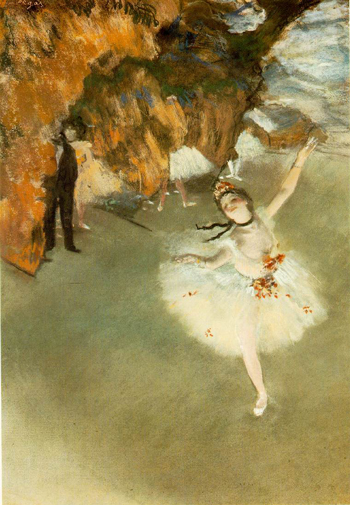| Search Art Prints | ||||||||||||||||||||
| Search Artists | ||||||||||||||||||||

|
||||||||||||||||||||
|
|
|||||||||||||||||||

The Star - Dancer on Stagealso known as L'Etoile - La Danseuse sur la Scene

|
In the 1870’s Degas began turning out an increasing number of ballet pictures such as, The Star. They were an immediate success. Why did Degas paint dancers so often? One theory is that the writer Ludovic Halevy who published a series of short stories recounting the lives of two young dancers and for whom Degas later went on to illustrate his work gave Degas an insight and keen understanding into the world of the dancer.
The Star, certainly one of Degas’ more famous paintings captures the dancer so vividly it is almost as if she is actually dancing. As Joris Karl Huysman said in a review of Degas’s work at an exhibition in 1880, “When your eyes are trained on these leaping figures, the illusion becomes so complete that they all come to life and gasp for breath.” Part of the reason Degas is so successful in creating the illusion that his dancers are moving is by his use of shadow and light as is demonstrated in The Star. The painting has the observer sitting in a box above the stage.
However, Degas has not only allowed us the view onstage, but we are also granted an even fuller picture of the life of a dancer by being able to witness what is happening in the wings as well. We see not only the magic of the theatre but the real life behind it. One can see the other dancers waiting in the wings and even a man dressed for the theatre who is perhaps a friend of the young Star.
For ten years Degas concentrated on painting dancers and ballerinas in rehearsal, resting, and on stage. In 1978, he was preoccupied with a new method of art where he would use pastel in order to render the vaporous quality of the ballerina’s tutu. In The Star, he contrasts areas that have been quickly colored in, with others that are meticulously finished. Some particularly light areas, such as the leg and neck of the dancer, are balanced with darker areas, such as the man on the left and the dancer’s ribbon. These effects create a fantastic reality, which mimics the fantasy of the stage.
Degas painted far more rehearsals than performances. The only significant difference between the two scenarios is his treatment of light. On stage, the light is bright and harsh, casting sharp shadows and blurring the dancer’s face. In rehearsals, the light is filtered in through windows to create a soft twilight, with flickering shadows.
In The Star, the ballerina performs her “pas seul” as she leaps towards the orchestra pit with a non-chalence that caused one critic to describe it as positively alarming, and that if he had been the conductor he would have been rushing to her aid. The dancer is floating bird-like and vulnerable in the center of an open, undefined space. The slant and angle of the painting is dizzying, creating a feeling of suspense, as the dancer appears to be preparing to fly off the stage.
This painting captures the pure unadulterated joy of dance. Every fiber of her being vibrates with the sensation that at this very moment there is nothing she would rather be doing. The Star is living out her bliss and it flows out from the painting to create this same feeling of pure joy in us as we look at the painting. It allows us to recapture moments of our life when we too were so engrossed in an activity we totally connected to, that nothing else in the world even existed for us. With her arms stretched out to us it is as if she is calling us to join the dance with her.
Interestingly, this painting was bought by Degas’ painting colleague Gustave Caillebotte, who is known for his drastic use of perspective.











